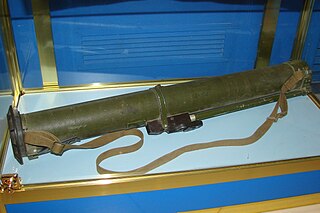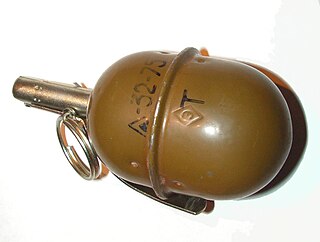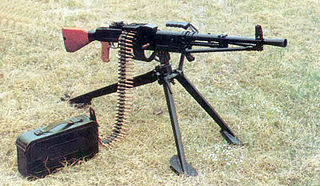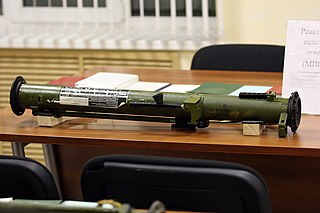Related Research Articles

The RPG-26 Aglen is a disposable anti-tank rocket-propelled grenade (RPG) launcher developed by the Soviet Union. It fires a one-stage rocket with jack-knife fins, which unfold after launch. The rocket carries a 72.5-millimetre (2.85 in) diameter high-explosive anti-tank (HEAT) single shaped charge warhead able to penetrate 440 millimetres (17 in) of armour, 1 metre of reinforced concrete or 1.5 metres of brickwork. It has a maximum effective range of around 250 metres (820 ft). The similar sized rocket features a slightly heavier and more powerful HEAT warhead and more powerful rocket engine. The limited extension of the RPG-22 launch tube was found of little use. Thus, the RPG-26 has a rigid non-telescoping launch tube.

The RGD-5 is a post–World War II Soviet anti-personnel fragmentation grenade, designed in the early 1950s. The RGD-5 was accepted into service with the Soviet Army in 1954. It was widely exported, and is still in service with many armies in the Middle East and the former Soviet bloc.

The ZPU is a family of towed anti-aircraft guns based on the Soviet 14.5×114mm KPV heavy machine gun. It entered service with the Soviet Union in 1949 and is used by over 50 countries worldwide.

The PTRS-41 is a World War II-era semi-automatic anti-tank rifle firing the 14.5×114mm cartridge.

The Type 67 is a general-purpose machine gun, chambered in 7.62×54mmR formerly used by the People's Liberation Army.

The Falaq-1 missile is an Iranian made rocket system. It was developed in the 1990s by Shahid Bagheri Industrial Group, which is part of the Aerospace Industries Organization.

The MAC 50 is a standard semi-automatic pistol of the French army and adopted in 1950. It replaced the previous series of French pistols, the Modèle 1935A & Modèle 1935S, and was produced between 1950 and 1970 with around 341,900 being created during that timeframe.

The 2S9 NONA is a self-propelled and air-droppable 120 mm mortar designed in the Soviet Union, which entered service in 1981. The 2S9 chassis is designated the S-120 and based on the aluminium hull of the BTR-D airborne multi-purpose tracked armoured personnel carrier. More generally, the 120 mm mortar is referred to as the Nona, with the 2S9 also known as the Nona-S. Although no figures have been released, it is estimated that well over 1,000 2S9 were built.
The SAN 511, formerly OM 50 Nemesis, is a bolt-action sniper rifle made by Swiss manufacturer Swiss Arms. It was created in early 21st century. It fires the .50 BMG cartridge. It is a derivative of the French sniper rifle Hecate II made by the manufacturer PGM. It has a reported accuracy of 0.5 minute of arc (MOA) at 300 m (980 ft) and under 1 MOA at 1,000 m (3,300 ft).
The SMArt 155 is a German 155 mm artillery round designed for a long-range, indirect fire top-attack role against armoured vehicles. The projectile was developed in 1989 by Diehl BGT Defence in Überlingen, Germany, with Rheinmetall and started full-rate production for the German Army in 1998. It consists of a 47-kilogram (104 lb) heavy artillery projectile containing two autonomous, sensor-fused, "fire-and-forget" submunitions. Due to the submunitions, it has been considered by some to be a cluster munition. As of 2008, representatives of the German defense ministry have referred to it as not being classified as submunition weapons, which were prohibited by the 2008 Convention on Cluster Munitions.

The Libyan Army is the brand for a number of separate military forces in Libya, which were under the command of the internationally recognised Government of National Accord (GNA).

The GM-94 is a pump action grenade launcher for use by Russian special and security forces. Development of the GM-94 grenade launcher began in 1993, under the guidance of Vasilij Gryazev, chief designer of the KBP design bureau (Konstruktorskoye Byuro Priborostroyeniya;, in Tula, Russia.

The MRO Borodach is a Russian self-contained, disposable single shot 72.5 mm rocket launcher.
Jonathan Steven Ferguson is a British firearm historian and author who is currently the Keeper of Firearms and Artillery at the Royal Armouries Museum in Leeds, England. He is also a technical specialist with Armament Research Services, a consultancy firm.
The most significant using of incendiary weapons were used a number of times during the Russo-Ukrainian War. Russians were accused of using white phosphorus bombs multiple times; in the Battle of Kyiv and against Kramatorsk in March 2022, against dug-in defenders at the Azovstal steel plant in Mariupol in May 2022, and in Marinka over the 2022 Christmas holiday. White phosphorus is a toxic chemical, and exposure to vapors leads to long-term ailments of the body, up to permanent disfigurement and death through organ failure.
References
- ↑ "Services - Armament Research Services (ARES)". armamentresearch.com. Retrieved 2024-01-14.
- ↑ "Silah Report Joins Armament Research Services!". silahreport.com. Retrieved 2024-01-14.
- ↑ "Arms and munitions intelligence specialist. Director, Armament Research Services (ARES). Editor, Armax: The Journal of Contemporary Arms". twitter.com. Retrieved 2014-01-14.
- ↑ "Armament Research Services". securesustain.org. Retrieved 2024-01-14.
- ↑ Dullum, Ove S.; Fulmer, Kenton; Jenzen-Jones, N.R.; Lincoln-Jones, Chris; Palacio, David (January 2017). "Indirect Fire: A technical analysis of the employment, accuracy, and effects of indirect-fire artillery weapons" (PDF). icrc.org. Retrieved 2024-01-14.